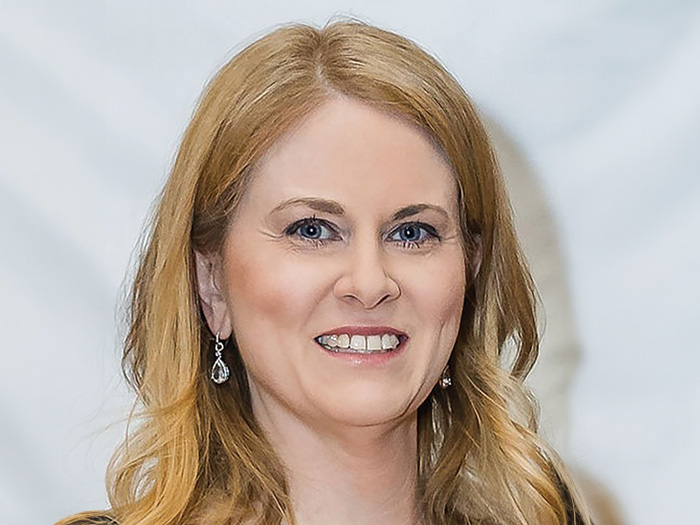A Titanic Talent: Newfront’s Amanda Rentfrow

Winding through Experiential Media Group’s Titanic exhibit in Las Vegas, visitors will see a number of objects retrieved from the shipwreck.
There’s jewelry, gloves and pocket watches worn by the ship’s patrons, gold mesh purses and binoculars.
Patrons can imagine the lives the people on the ship led — and lost.
At the beginning of the tour, visitors receive the name of a passenger when they enter the exhibit. By the end, they learn whether or not that individual survived.
“Everybody’s still — over 110 years later — so interested in the Titanic,” said Amanda D’Angelo Rentfrow, ARM, senior vice president and entertainment practice leader with Newfront.
“You can see the china the passengers ate on. It was still intact. And there’s small cologne bottles. You can live the story.”
E/M Group’s affiliate RMS Titanic Inc. has conducted eight research expeditions to the Titanic’s ruins, recovering more than 5,500 artifacts
for preservation. The exhibit is only possible because it has the insurance coverage and risk management guidance it needs to keep these
artifacts safe.
It takes a talented broker to understand the risks of a company that displays and preserves objects that spent decades at the bottom of the Atlantic. The objects need to be stored and displayed with temperature and humidity controls. Security staff need to make sure visitors to the exhibit don’t touch items, which could be easily damaged.
Rentfrow is that broker. She has worked with E/M Group for more than 15 years, helping them purchase needed insurance policies and
offering risk management advice. It’s that kind of attention to detail and dedication to her clients that makes Rentfrow a 2024 Power Broker®.
Strong Client Relationships
Rentfrow got her start in the insurance industry after working in retail for Rich’s, a department store that was bought by Macy’s in the aughts. Rentfrow loved how personable retail was — interacting with customers brought her joy — but she hated the unpredictable hours.
She had studied finance and risk and insurance as an undergraduate student at the University of South Carolina, so when Aon had an opening for a project manager in its entertainment practice, she thought it sounded like a good fit.
It ended up being life-changing.
Her boss was encouraging. He ran a $26 million entertainment book, which he grew to more than $90 million by the time he left Aon, but he still took the time to answer her questions and teach her about the unique insurance needs their entertainment clients face.
Entertainment brokers work with a wide variety of insureds, from golf resorts and amusement parks to celebrities and film productions. Each one comes with its own set of insurance requirements.
“It really is the exciting side of insurance,” Rentfrow said. “A lot of our clients have counted on us to make sure that they are fully protected in ways that maybe they haven’t thought about.”
In some cases, brokers need to step in and ensure their clients understand the risks associated with their events.
Rentfrow recalls working with a radio station that would pitch crazy events, like slap contests, without necessarily considering the ramifications. The events resulted in a few damaged retinas and embarrassment claims.
“If you don’t involve your risk team, crazy things can happen,” she said.
Rentfrow believes it’s her job to guide clients through those risks — especially these days, when exposures shift rapidly.
“Obviously, everyone’s got more on their plate than ever before,” Rentfrow said.
“I’m doing the best I can for them, and I keep abreast of what’s going on.”
Weathering the COVID-19 Event Cancellation Storm
During the COVID-19 pandemic, Rentfrow’s ability to keep track of and advise her clients on a variety of everchanging exposures came in handy.
But for many, it wasn’t their first time working through a crisis with her.
They knew they could rely on her during the pandemic because she had helped them many times before.
“We weathered many storms, including COVID, together,” she said.
One client, which puts on live events, was grateful they had purchased event cancellation policies. They knew they couldn’t pivot to virtual. Their insurance policy saved them.
“A lot of our clients purchased event cancellation with a communicable disease cover, which was very easy pre-COVID. It was honestly a throw-in for a lot of event cancellation policies,” Rentfrow said.
Now, that’s not the case. Carriers have brought more scrutiny to their event cancellation business, and many have added exclusions for
communicable diseases.
Today, entertainment businesses are facing many of the same challenges as other companies as they navigate the world after shutdowns. Property markets have been strained in recent years as inflation pushes up the costs of rebuilding after a claim.
Rentfrow is prepared to navigate these challenges, however. She has experience working with golf courses and other clients to create parametric insurance policies, those that pay out immediately once a specific predefined event occurs.
For one, she helped create a policy where the client received a payout to repair its golf courses if a certain amount of rain occurred in an area.
She believes these types of coverages will only become more common.
“The property marketplace has deteriorated rapidly over the past year to two,” Rentfrow said.
“We have looked and continue to look more towards parametrics and alternative risk structures,” she said.
“I think you’ll see more and more of that coming out in entertainment and the rest of the marketplace.”
Of course, Rentfrow wouldn’t be as successful as she is if her clients weren’t willing to listen to her advice and be just as willing to act on her recommendations. Reflecting on her client, E/M Group, she notes that they really understand the responsibility and the joy of protecting the artifacts salvaged from the Titanic’s ruins.
“It comes with a certain responsibility to keep the artifacts as safe as possible in their displays and in storage,” she said. “They
understand risk.” &











